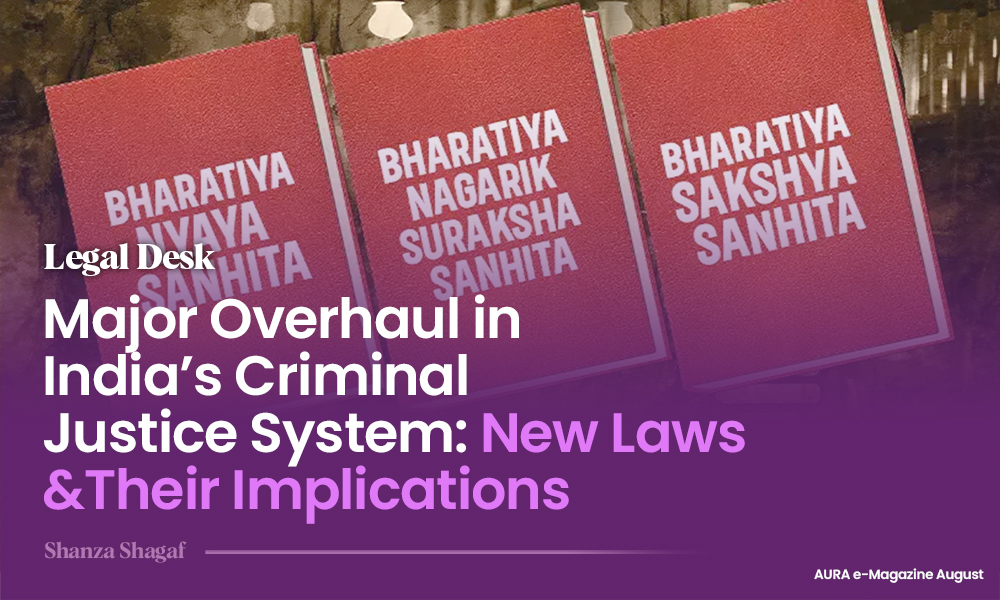Introduction
India has recently introduced a comprehensive overhaul of its criminal justice system with the enactment of three new laws: the Bharatiya Nyaya Sanhita (BNS), the Bharatiya Nagarik Suraksha Sanhita (BNSS), and the Bharatiya Sakshya Adhiniyam. These laws replace the long-standing Indian Penal Code (IPC), the Code of Criminal Procedure (CrPC), and the Indian Evidence Act. The new legislation aims to modernise the legal framework, focusing on victim-centric approaches, incorporating new technologies, and addressing contemporary criminal activities. However, civil society and legal activists have several concerns regarding these laws.
One of the notable amendments is the Criminal Law (Amendment) Act, which includes stricter penalties for sexual offences, particularly enhancing protections for women and children. This act introduces measures like the death penalty for certain cases of rape. It reduces the duration for investigation and trial, aiming to ensure swifter justice and greater deterrence against such crimes.
Another area of concern is that the National Investigation Agency (NIA) Act has also been amended, expanding the NIA’s powers to investigate a broader range of crimes, including human trafficking, counterfeit currency, and cyber-terrorism. This may add to the increasing surveillance regime that already exists.
In response to the increasing incidents of mob violence, several states have introduced specific anti-mob lynching laws. These laws provide stringent punishments for perpetrators and establish special courts to expedite trials. Data protection has also become a critical focus, with new regulations concerning data privacy and cybercrime being introduced. These laws aim to safeguard personal information and curb cyber offences, addressing the growing concerns over digital security and privacy in an increasingly interconnected world.
Furthermore, there is a move towards decriminalising certain minor offences and promoting alternative dispute-resolution mechanisms. This approach aims to reduce the burden on the judicial system, allowing it to focus on more serious crimes while providing quicker and more amicable resolutions for lesser offences.
However, the recent changes in criminal law enforcement in India have raised concerns about the balance between public safety and individual rights. One such issue is the increased use of handcuffs during arrests, which can imply guilt rather than mere accusation. This practice challenges the principle of “innocent until proven guilty”. It can lead to social and personal repercussions for those who are only suspects in the early stages of an investigation. Another concern is the extended detention powers granted to the police, which could undermine the writ of habeas corpus, a fundamental legal remedy against unlawful detention. Individuals may find it harder to challenge unlawful imprisonment and secure their release with these broader powers.
Additionally, the extension of police & judicial custody from the usual 15 days to 60 or even 90 days in some cases raises significant human rights concerns. Such prolonged detention can lead to deprivation of liberty without a trial, increasing the risk of coercion & mistreatment of detainees. There is also a move towards converting certain punishments into community service, such as working at traffic signals with police or planting trees with NGOs. While this can promote rehabilitation, it raises questions about consistency and fairness in the legal system.
Furthermore, the broadening definition of terrorism to include vaguer terms can dilute the gravity of genuine threats and potentially criminalise lesser acts of dissent or protest. This shift blurs the line between legitimate protest & criminal activity, infringing upon civil liberties. Reducing bureaucratic oversight for actions such as lathi charges, where police no longer need approval from a Divisional Officer, has sparked concerns about unchecked police power. While intended to improve response times in critical situations, it increases the risk of excessive force and abuse of authority. These changes highlight the need for balanced reforms that protect individual rights while ensuring public safety.
Conclusion
In conclusion, the recent changes in criminal laws in India present a complex interplay of positive & negative impacts. On the positive side, these reforms aim to enhance public safety, streamline law enforcement procedures, & introduce more rehabilitative approaches to punishment. They reflect an effort to modernise the legal system, address contemporary challenges, & improve the efficiency of the justice process. However, these changes also raise significant concerns about potential overreach, erosion of civil liberties, & the risk of abuse of power. The extended detention periods, broader definitions of terrorism, & increased autonomy of police actions could undermine fundamental rights & principles of justice. Balancing these reforms to protect individual freedoms while ensuring effective law enforcement is crucial. Policymakers must ensure that these laws are implemented with transparency, accountability, & fairness to maintain public trust & uphold the justice system’s integrity.


0 Comments